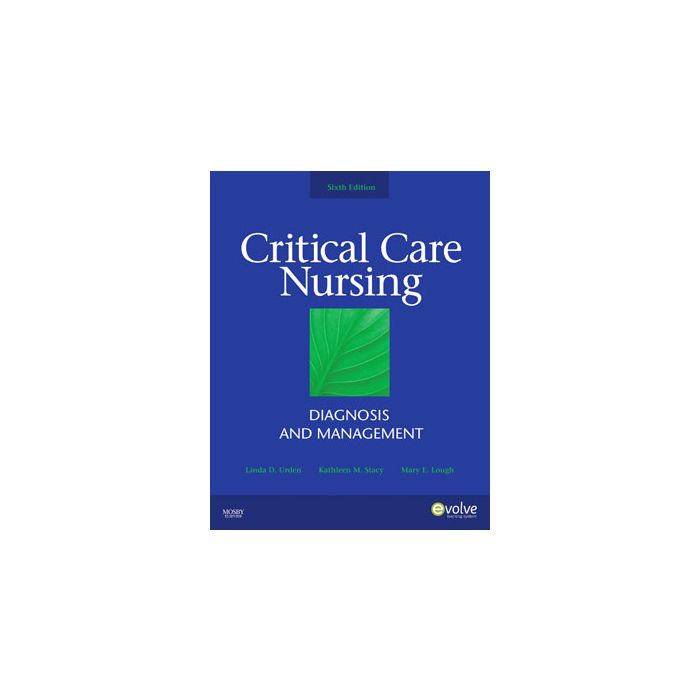Critical Care Nursing, 6th Edition -Diagnosis and Management

- ISBN/EAN
- 9780323057486
- Editore
- Elsevier Science
- Anno
- 2010
- Pagine
- Pag. 1232<br> Mosby<br> Hardcover
Disponibile
98,99 €
Adaptable to any nursing framework, this classic resource provides clear, comprehensive coverage of every aspect of critical care nursing practice. It’s organized in nine units around alterations in body systems, with a focus on evidence-based practice, collaborative management, and patient safety. The depth and scope of this textbook make it a long-lasting value that you will rely on throughout nursing school and well into clinical practice.
Key Features
-Evidence-Based Practice: Collaborative and Evidence-Based Practice: Nursing boxes offer the latest evidence-based management guidelines for both collaborative and nursing care and highlight the importance of basing practice on strong evidence.
-Collaborative Management boxes examine the interdependence of nursing and medical practice and demonstrate the importance of teamwork in the management of critical care patients.
-Pharmacologic Management tables in each therapeutic management chapter provide a quick summary of drug names, recommended dosages, drug actions, and special considerations for the drugs most often used in critical care.
-Nursing Diagnoses boxes in every disorders chapter list common diagnoses in priority order for each body system, encouraging critical thinking and effective decision-making.
-Patient Safety Alerts highlight potential safety issues related to chapter content as identified by the Joint Commission.
-UNIQUE! Data Collection boxes in assessment chapters outline all the information required for a complete patient assessment.
-Patient Education boxes offer quick access to the concepts that must be taught to the patient and the family before discharge from the ICU.
-Nursing Interventions Classification (NIC) boxes list the important nursing actions for a variety of nursing interventions that are part of the therapeutic management of a critically ill patient.
Key Features
-Evidence-Based Practice: Collaborative and Evidence-Based Practice: Nursing boxes offer the latest evidence-based management guidelines for both collaborative and nursing care and highlight the importance of basing practice on strong evidence.
-Collaborative Management boxes examine the interdependence of nursing and medical practice and demonstrate the importance of teamwork in the management of critical care patients.
-Pharmacologic Management tables in each therapeutic management chapter provide a quick summary of drug names, recommended dosages, drug actions, and special considerations for the drugs most often used in critical care.
-Nursing Diagnoses boxes in every disorders chapter list common diagnoses in priority order for each body system, encouraging critical thinking and effective decision-making.
-Patient Safety Alerts highlight potential safety issues related to chapter content as identified by the Joint Commission.
-UNIQUE! Data Collection boxes in assessment chapters outline all the information required for a complete patient assessment.
-Patient Education boxes offer quick access to the concepts that must be taught to the patient and the family before discharge from the ICU.
-Nursing Interventions Classification (NIC) boxes list the important nursing actions for a variety of nursing interventions that are part of the therapeutic management of a critically ill patient.
Maggiori Informazioni
| Autore | Urden - DNSc - RN - CNA-BC - FAAN - Stacy - MS - |
|---|---|
| Editore | Elsevier Science |
| Anno | 2010 |
| Tipologia | Libro |
| Lingua | Inglese |
| Indice | UNIT I. FOUNDATIONS OF CRITICAL CARE NURSING Critical Care Nursing Practice Ethical Issues Legal Issues Genetics in Critical Care NEW! Patient and Family Education Psychosocial Alterations Sleep Alterations and Management Nutrition Alterations and Management Pain and Pain Management Sedation, Agitation, Delirium: Assessment and Management End-of-Life Issues UNIT II. SPECIAL POPULATIONS The Pediatric Patient in the Adult Critical Care Unit High-Risk and Critical Care in Obstetric Issues Gerontologic Alterations and Management Perianesthesia Management UNIT III. CARDIOVASCULAR ALTERATIONS Cardiovascular Anatomy and Physiology Cardiovascular Clinical Assessment Cardiovascular Diagnostic Procedures Cardiovascular Disorders Cardiovascular Therapeutic Management UNIT IV. PULMONARY ALTERATIONS Pulmonary Anatomy and Physiology Pulmonary Clinical Assessment Pulmonary Diagnostic Procedures Pulmonary Disorders Pulmonary Therapeutic Management UNIT V. NEUROLOGIC ALTERATIONS Neurologic Anatomy and Physiology Neurologic Clinical Assessment and Diagnostic Procedures Neurologic Disorders and Therapeutic Management UNIT VI. RENAL ALTERATIONS Renal Anatomy and Physiology Renal Clinical Assessment and Diagnostic Procedures Renal Disorders and Therapeutic Management UNIT VII. GASTROINTESTINAL ALTERATIONS Gastronintestinal Anatomy and Physiology Gastronintestinal Clinical Assessment and Diagnostic Procedures Gastronintestinal Disorders and Therapeutic Management UNIT VIII. ENDOCRINE ALTERATIONS Endocrine Anatomy and Physiology Endocrine Clinical Assessment and Diagnostic Procedures Endocrine Disorders and Therapeutic Management UNIT IX. MULTISYSTEM ALTERATIONS Trauma Shock Systemic Inflammatory Response Syndrome and Multiple Organ Dysfunction Syndrome Burns Organ Donation and Transplantation Hematologic Disorders and Oncologic Emergencies APPENDIX A: Nursing Management Plans of Care APPENDIX B: Physiologic Formulas for Critical Care |
Questo libro è anche in:
